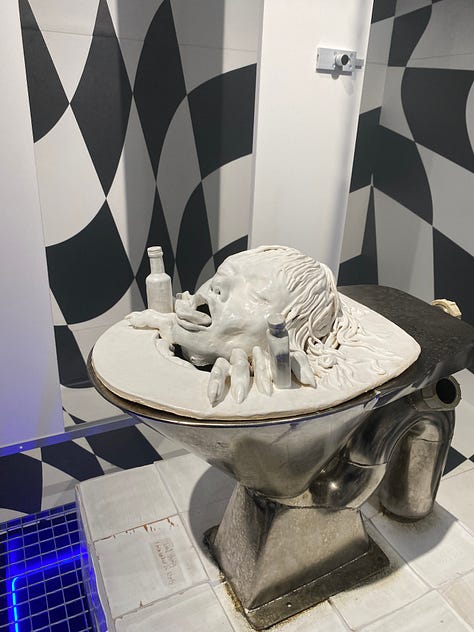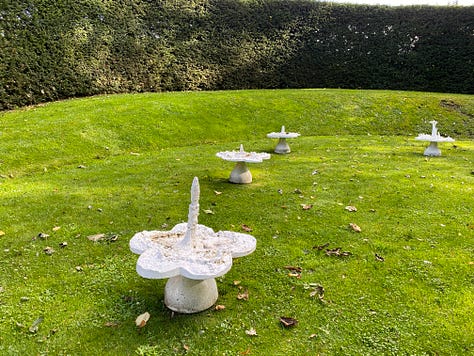In August this year, Greta Thunberg withdrew from the Edinburgh Book Festival after it emerged that its main sponsor, Baillie Gifford, invests in firms that profit from fossil fuels. Another fifty or so authors signed an open letter threatening to boycott the 2024 event. Mikaela Loach staged a walkout at her event, saying "Edinburgh International Book Festival wouldn't burn books, so why are they ok with burning the planet?"
Such performative outrage can make a difference. Nan Goldin’s protest against the Sackler Family, who made billions from addictive opioids, led to museums removing the name from their buildings. On the other hand, I don’t want to discourage the ultrarich — whether good or evil — from spending money funding the arts rather than, say, buying private jets.
The book festival controversy was on my mind when I visited Jupiter Artland, a sculpture park on the outskirts of Edinburgh. I learned that it was set up as a charitable foundation by Robert and Nicky Wilson, a couple of philanthropic art collectors. They hadn’t made their money from slavery, opioids or oil. Quite the opposite. They made it from homeopathy, a form of medicine where the active ingredient is diluted until all you have is a placebo. Some might say this is the perfect metaphor for contemporary art. However, the Wilson family didn’t establish the company. They bought it in the 1970s having originally got rich from pet food brands like Kattomeat and Kennomeat. Surely no artist could object to money derived from homeopathy and pet food.
I mentioned this investigative journalism to my friend, Camilla Grudova, as we took the bus from Princes Street to Jupiter Artland.
“What I heard,” she replied, “is that they are members of a cult."
"Oh really," I said, my ears perking up.
"It’s called Zoence or something and they perform secret rituals in a crystal cave. When they bring the members in they send all the staff home. No one knows what they get up to.”
We did a Google search for Zoence and discovered a website full of benign new-age references. We tried searching for “zoence controversy” and “zoence cult” but found nothing. Nevertheless, upon entering Jupiter Artland, I was fully expecting a mystical encounter
For a long time, I’ve been looking for a nature religion. Rationalism doesn’t seem to do enough to convince humanity to stop damaging the planet. Perhaps we need new rituals and traditions to help see the natural world as sacred.
The centrepiece of Jupiter Artland is Charles Jencks’ Cells of Life, a set of mounds with sculptures of sperm on top of them. Jencks is known for his writing on postmodernism and his fascination with science. I wonder if this extended to the Zoence idea of geomancy, “a science of earth energy, form and consciousness."
When I got home to do more research, chatGPT told me that:
One of the central ideas in Zoence is the belief in "landscape temples." These are natural and man-made features in the landscape that are thought to be aligned in a way that is energetically significant. These can be ancient megaliths, sacred sites, or other significant landmarks.
Zoence was invented by Peter Dawkins (no relation to Richard) and is deeply embedded in Western occultism. The examples given on their website include, “Rosicrucianism, Neoplatonism, and the Hermetic, Magian, Hebraic, Orphic, Classical, Celtic and Christian traditions.” The co-founder of Jupiter Artland and inheritor to the Kennomeat millions was on the Zoence Foundation board, so it is interesting to speculate on whether the sculpture park might be connected.
The main temporary exhibition this year was Lindsay Mendick’s Sh*tfaced, which was about the highs and lows of alcohol. With its ceramic pigs having sex on a dance floor, it certainly didn't feel connected to the natural world, unless we’re on Circe’s island and have all been transformed into swine.



More earthbound paganism can be found throughout the park. Tracey Emin’s I Lay Here for You is an enormous bronze woman who lies on the ground with her arse in the air. Helen Chadwick’s Piss Flowers are weirdly phallic. Anish Kapoor’s Suck is an anus-like hole in the ground protected by a cage. We are not in the realm of the transcendent.



After much searching, we found Anya Gallaccio’s The Light Pours Out of Me, the amethyst cave mentioned earlier.
"I can feel it, the energy," said Camilla as we descended the steps into a cuboid space covered in gemstones.
Indeed, it was a rapturous place, as light glimmered on the crystal walls. “Amethysts are reported to open a person’s third eye. The third eye is considered to be a source of power and wisdom.”1 We spoke with a woman, a self-proclaimed meditator, who had just spent £7 in the shop on a ratty piece of amethyst. She was in heaven and didn’t want to leave.
"I have to get out,” said Camilla. “I feel I'm drying with the salt."
Is there actual power in these places or is it just magical thinking? When I look at pictures and videos of Peter Dawkins I don’t see someone who is charged with supernatural energies. He’s more of a kindly man who looks like he goes out hiking a lot. Engaging with esoterica and occultism makes the world playful, it’s like LARPing on the weekend.
Friedrich Nietzsche announced that “God is dead” in 1882, but God and religion persisted in zombie form for a lot longer. As a child, I would sing hymns at school and go to church at key points in the year. But even this pale version of Christianity seems to be dying out. In its place, things like astrology and WitchTok are emerging, practices that allow young people to cope with the uncertainty of the modern world.
At the end of The Bird That Never Flew, a lament for endangered and extinct birds, which was recently performed in Glasgow Cathedral, Hanna Tuulikki sings “It lies in your hands.” It doesn’t feel that way though. The invisible hand of capitalism controls us as if we were marionettes. In the absence of agency, no wonder we seek out mysticism.
By the way, Camilla Grudova’s new book The Coiled Serpent is published next week. See her on her book tour.
Via Healthline.com








Interesting read.
Coincidentally I’ve been reading ‘Post-Modern Buildings’ in Britain by Geraint Franklin and Elain Harwood today (researching a future Substack of photos from Aztec West business park) and this Charles and Maggie Jencks landscape is featured. I visited their fascinating home in London a few months ago which was appropriately called the Cosmic House…
Very interesting read! I like your idea of homeopathy and contemporary art.